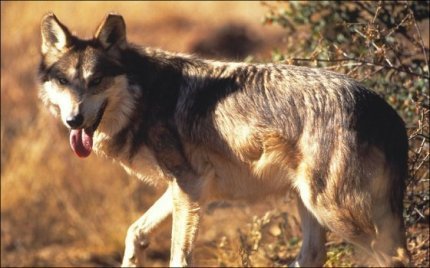Press Release: 2011 Mexican Wolf Population Survey Complete
Contacts: Tom Buckley, (505) 248-6455, Tom_Buckley@fws.gov
Lynda Lambert (623) 236-7203 llambert@azgfd.gov
 A minimum of 58 Mexican wolves were counted in the wild in Arizona and New Mexico at the end of 2011, according to the annual survey completed by the Mexican wolf Interagency Field Team (IFT).
A minimum of 58 Mexican wolves were counted in the wild in Arizona and New Mexico at the end of 2011, according to the annual survey completed by the Mexican wolf Interagency Field Team (IFT).
Compared to the 2010 minimum population count of 50 wolves, this number demonstrates an increase in the known population in the wild.
“These numbers are an indication of the full-on effort we and our partners — Arizona Game and Fish Department, White Mountain Apache Tribe, USDA Forest Service, USDA Wildlife Services and several participating counties — have been putting into this program. We were successful in establishing the initial population of Mexican wolves in the wild, and we are building on that success.” said Benjamin Tuggle, the U.S. Fish and Wildlife Service’s Southwest (Service) Regional Director. “Our team is addressing the two biggest threats to Mexican wolf recovery, limited genetic diversity and illegal mortality, and I am certain that we will overcome them.”
“We have worked in coordination with our partners to decrease wolf livestock interactions. In addition, the Mexican Wolf Interdiction Program, a non-profit fund, has been able to provide compensation for livestock losses. Keeping wolves in the wild is a collaborative effort,” Tuggle said.
The Service, in concert with our partners, reviews each case of confirmed wolf depredation separately and determines the best management response for that situation. The goal is to keep as many wolves in the wild as possible. The Service has only had to permanently remove one wolf in the last five years.
“Proactive management by the Interagency Field Team is critical to addressing depredation issues by working with local stakeholders and constituents, to increase the number of wild wolves on the ground and build public trust,” said Larry Voyles, Director of the Arizona Game and Fish Department. “Retention of wild wolves on the ground is an important factor in growing the population.”
Voyles pointed out that reducing wolf-livestock interactions is the key to building tolerance for the presence of wolves on public lands.
“Building public tolerance by those who live on the land and must coexist with the wolf is so very important to the success of Mexican wolf recovery in Arizona,” said Voyles. “To that end, we have seen an increase in numbers this past year, even with Arizona’s largest wildfire, the Wallow, which burned through three packs’ denning areas during the time pups were being born and raised.”
The results of the surveys reflect the end of year population for 2011, and include population data collected on the ground by the IFT from November 2011 through the end of the year as well as data collected from an aerial survey conducted in January 2012. This number is considered to be a minimum number of wolves known to be alive. Other non-collared wolves not located during the survey period may be present in the Blue Range Wolf Recovery Area.
The aerial survey was conducted by a fixed-wing aircraft and helicopter. Biologists used radio-telemetry and actual sightings of wolves to help determine the count. The results from the aerial survey, coupled with the ground survey conducted by the IFT, confirmed that there are 26 wolves – 6 packs in New Mexico, 32 wolves – 6 packs in Arizona. The survey indicated that there were 6 pairs that met the federal definition of breeding pairs at year’s end.
Pups born in the summer must survive to December 31 of the given year to be counted as part of the Mexican wolf population. Of the 58 wolves, 18 were wild born pups that survived through the end of the year. This is the same number of pups surviving to the end of the year as in 2010. This is also considered a minimum known number since it might not reflect pups surviving but not documented.
Photo courtesy of US Fish and Wildlife Service



